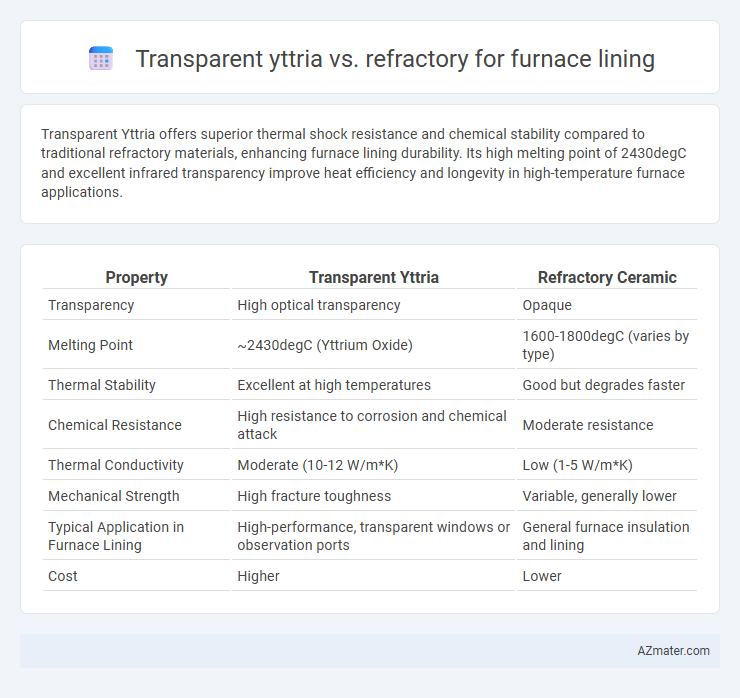Transparent Yttria offers superior thermal shock resistance and chemical stability compared to traditional refractory materials, enhancing furnace lining durability. Its high melting point of 2430degC and excellent infrared transparency improve heat efficiency and longevity in high-temperature furnace applications.
Table of Comparison
| Property | Transparent Yttria | Refractory Ceramic |
|---|---|---|
| Transparency | High optical transparency | Opaque |
| Melting Point | ~2430degC (Yttrium Oxide) | 1600-1800degC (varies by type) |
| Thermal Stability | Excellent at high temperatures | Good but degrades faster |
| Chemical Resistance | High resistance to corrosion and chemical attack | Moderate resistance |
| Thermal Conductivity | Moderate (10-12 W/m*K) | Low (1-5 W/m*K) |
| Mechanical Strength | High fracture toughness | Variable, generally lower |
| Typical Application in Furnace Lining | High-performance, transparent windows or observation ports | General furnace insulation and lining |
| Cost | Higher | Lower |
Introduction to Furnace Lining Materials
Furnace lining materials must endure extreme temperatures while providing thermal insulation and chemical stability. Transparent yttria offers superior optical clarity and high melting points around 2430degC, making it ideal for specialized high-temperature applications requiring visibility and durability. In contrast, refractory materials like alumina and silica provide excellent thermal insulation and resistance to thermal shock, commonly used to protect furnace structures under severe operating conditions.
Overview of Transparent Yttria
Transparent Yttria offers exceptional optical clarity and high thermal stability, making it ideal for furnace linings in high-temperature applications where visibility and resistance to thermal shock are critical. Its low absorption of infrared radiation contributes to energy efficiency, while the superior chemical inertness prevents degradation under aggressive furnace atmospheres. Compared to traditional refractory materials, Transparent Yttria combines durability with transparency, enabling better monitoring of furnace conditions and improved process control.
What Are Refractory Materials?
Refractory materials are heat-resistant substances designed to withstand extreme temperatures in furnace linings, often composed of ceramics, alumina, silica, and magnesia. Transparent yttria, a specialized refractory, offers high thermal stability along with optical transparency, making it ideal for applications requiring visibility and durability under intense heat. Conventional refractory materials prioritize insulation and mechanical strength but generally lack the unique combination of transparency and thermal resistance that transparent yttria provides.
Thermal Stability: Yttria vs Traditional Refractories
Transparent yttria exhibits superior thermal stability compared to traditional refractory materials used in furnace linings, maintaining its structural integrity at temperatures exceeding 2300degC. Unlike conventional refractories such as alumina or silica-based bricks, yttria demonstrates a lower thermal expansion coefficient and enhanced resistance to thermal shock, minimizing crack formation and degradation. These properties result in longer service life and improved furnace efficiency, especially in applications involving extreme heat and rapid temperature fluctuations.
Chemical Resistance Comparison
Transparent yttria offers superior chemical resistance compared to traditional refractory materials used in furnace lining, effectively withstanding aggressive molten metals and corrosive slags. Its high purity and stable oxide structure minimize interactions with chemical agents, reducing contamination and extending furnace lifespan. Refractory materials, while cost-effective, often show susceptibility to chemical degradation and erosion under high-temperature, chemically harsh environments.
Optical Transparency Benefits in Furnace Linings
Transparent yttria offers superior optical transparency compared to traditional refractory materials, enabling precise monitoring of furnace conditions and enhancing process control through real-time visual inspection. Its high melting point and thermal stability maintain structural integrity at extreme temperatures while allowing light transmission, which refractory linings lack due to their opaque nature. Utilizing transparent yttria in furnace linings significantly improves operational efficiency by facilitating early detection of faults and better heat distribution management.
Mechanical Strength and Durability
Transparent Yttria exhibits superior mechanical strength compared to traditional refractory materials, offering enhanced resistance to thermal shock and abrasion in furnace linings. Its high melting point above 2430degC and chemical inertness ensure prolonged durability under extreme operating conditions. Refractory linings, while cost-effective, often suffer from gradual degradation, making Transparent Yttria an optimal choice for high-performance furnace applications requiring extended service life.
Installation and Maintenance Considerations
Transparent yttria offers superior thermal stability and chemical inertness compared to traditional refractory materials, making it an excellent choice for high-temperature furnace linings. Installation of transparent yttria requires precise handling due to its brittleness and higher cost, but it reduces maintenance frequency by resisting corrosion and thermal shock effectively. Refractory linings, while easier and cheaper to install, demand more frequent inspections and repairs because they are prone to wear and degradation under extreme furnace conditions.
Cost Analysis: Transparent Yttria vs Refractory
Transparent Yttria offers superior thermal stability and corrosion resistance for furnace linings but comes with a significantly higher purchase cost compared to conventional refractory materials. While traditional refractory linings provide lower upfront expenses, they often require more frequent maintenance and replacement due to lower durability, leading to increased long-term operational costs. Evaluating the total cost of ownership, Transparent Yttria's longevity and performance can reduce downtime and maintenance expenses, potentially offsetting its initial investment over the furnace's lifecycle.
Future Trends in Furnace Lining Materials
Transparent yttria offers superior thermal stability and corrosion resistance, making it a promising candidate for advanced furnace linings under extreme conditions. Emerging trends emphasize the integration of nanostructured yttria composites and multilayer refractory coatings to enhance durability and energy efficiency. Future furnace lining materials will increasingly leverage transparent yttria's optical and thermal properties to improve real-time monitoring and reduce maintenance costs.

Infographic: Transparent Yttria vs Refractory for Furnace lining
 azmater.com
azmater.com